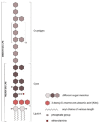Ruminal Lipopolysaccharides Analysis: Uncharted Waters with Promising Signs
- PMID: 33467503
- PMCID: PMC7831013
- DOI: 10.3390/ani11010195
Ruminal Lipopolysaccharides Analysis: Uncharted Waters with Promising Signs
Abstract
The objective of this review is to present the need for the development of a comprehensive ruminal lipopolysaccharide (LPS) extraction, purification and analysis protocol and state hypotheses that could contribute to planning novel strategies against ruminal acidosis. Lipopolysaccharide is an immunostimulatory molecule of Gram-negative bacterial outer membranes and has been reported to contribute to ruminal acidosis in cattle. Bacterial death and lysis are normal processes, and thus LPS is normally present in ruminal fluid. However, ruminal LPS concentration is much greater during subacute ruminal acidosis (SARA). Contrary to the widely known LPSs, ruminal LPS seems to be composed of a variety of LPS chemotypes that may interact with each other resulting in an LPS "mixture". Hypotheses regarding the influence of each specific ruminal bacterial specie to innate immunity during SARA, and the representativeness of the exclusive use of the Escherichia coli LPS to rumen epithelial tissue challenges, could expand our knowledge regarding SARA. In addition, possible correlation between the monomeric Toll-like Receptor 4 (TRL4) and the antagonistic penta-acylated lipid A of LPS could contribute to novel strategies to tackle this nutrition disorder.
Keywords: LBP; Prevotella; extraction protocol; ruminal LPS; single molecule localization microscopy.
Conflict of interest statement
The authors declare no conflict of interest.
Figures


Similar articles
-
Integrating Subacute Ruminal Acidosis, Lipopolysaccharide, and Trained Immunity: A Comprehensive Review.Int J Biol Sci. 2025 Mar 31;21(6):2806-2823. doi: 10.7150/ijbs.104074. eCollection 2025. Int J Biol Sci. 2025. PMID: 40303309 Free PMC article. Review.
-
Subacute ruminal acidosis affects fermentation and endotoxin concentration in the rumen and relative expression of the CD14/TLR4/MD2 genes involved in lipopolysaccharide systemic immune response in dairy cows.J Dairy Sci. 2018 Feb;101(2):1297-1310. doi: 10.3168/jds.2017-12896. Epub 2017 Nov 15. J Dairy Sci. 2018. PMID: 29153518
-
Ruminal lipopolysaccharide concentration and inflammatory response during grain-induced subacute ruminal acidosis in dairy cows.J Dairy Sci. 2007 Feb;90(2):856-66. doi: 10.3168/jds.S0022-0302(07)71569-2. J Dairy Sci. 2007. PMID: 17235162
-
Supplementing phytogenic compounds or autolyzed yeast modulates ruminal biogenic amines and plasma metabolome in dry cows experiencing subacute ruminal acidosis.J Dairy Sci. 2018 Oct;101(10):9559-9574. doi: 10.3168/jds.2018-14744. Epub 2018 Jul 19. J Dairy Sci. 2018. PMID: 30031584
-
Subacute ruminal acidosis (SARA) challenge, ruminal condition and cellular immunity in cattle.Jpn J Vet Res. 2015 Feb;63 Suppl 1:S25-36. Jpn J Vet Res. 2015. PMID: 25872324 Review.
Cited by
-
Ruminal bacteria lipopolysaccharides: an immunological and microbial outlook.J Anim Sci Biotechnol. 2022 Apr 14;13(1):41. doi: 10.1186/s40104-022-00692-5. J Anim Sci Biotechnol. 2022. PMID: 35418112 Free PMC article. Review.
-
Effects of ruminal lipopolysaccharides on growth and fermentation end products of pure cultured bacteria.Sci Rep. 2022 Sep 23;12(1):15932. doi: 10.1038/s41598-022-20073-2. Sci Rep. 2022. PMID: 36151241 Free PMC article.
-
Integrating Subacute Ruminal Acidosis, Lipopolysaccharide, and Trained Immunity: A Comprehensive Review.Int J Biol Sci. 2025 Mar 31;21(6):2806-2823. doi: 10.7150/ijbs.104074. eCollection 2025. Int J Biol Sci. 2025. PMID: 40303309 Free PMC article. Review.
References
-
- Papo N., Shai Y., Humphries J.D., Schofield N.R., Mostafavi-Pour Z., Green L.J., Garratt A.N., Mould A.P., Humphries M.J. A Molecular Mechanism for Lipopolysaccharide Protection of Gram-negative Bacteria from Antimicrobial Peptides. J. Biol. Chem. 2005;280:10378–10387. doi: 10.1074/jbc.M412865200. - DOI - PubMed
-
- Caradonna L., Amati L., Magrone T., Pellegrino N.M., Jirillo E., Caccavo D. Enteric bacteria, lipopolysaccharides and related cytokines in inflammatory bowel disease: Biological and clinical significance. J. Endotoxin Res. 2000;6:205–214. - PubMed
Publication types
LinkOut - more resources
Full Text Sources
Other Literature Sources
Miscellaneous

